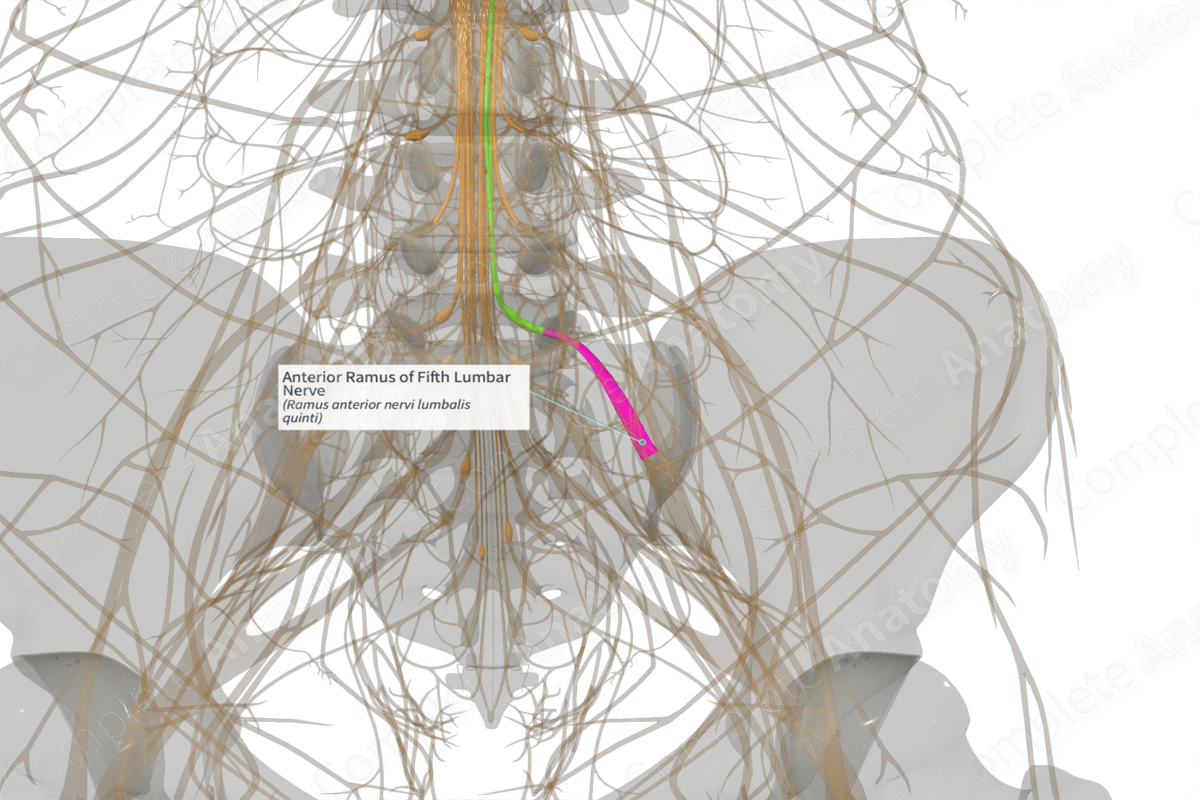
Anterior Ramus of Fifth Lumbar Nerve (Left)
Ramus anterior nervi lumbalis quinti
Read moreQuick Facts
Origin: From the fifth lumbar nerve (L5).
Course: The anterior ramus of L5 combines with the anterior ramus of L4 to form the lumbosacral trunk which contributes to the sacral plexus, situated on the posterolateral wall of the pelvic cavity, anterior to the piriformis muscle.
Branches: Grey ramus communicates, superior and inferior gluteal nerves, nerve to obturator internus, and nerve to quadratus femoris, branches of sciatic nerve, including the deep and superficial fibular, and tibial nerves.
Supply: Motor innervation to gluteal muscles (gluteus maximus, medius, and minimus, tensor fasciae latae, piriformis, obturator internus, superior and inferior gemelli, and quadratus femoris); hamstring muscles (hamstring part of adductor magnus, biceps femoris, semimembranosus, and semitendinosus); muscles of the anterior compartment of the leg (tibialis anterior, extensor hallucis longus, extensor digitorum longus, and peroneus tertius); the lateral compartment of the leg (peroneus longus and brevis); the posterior compartment of the leg (popliteus and tibialis posterior). Sensory innervation to the skin of the lower anterior part of the leg, dorsum of the foot, and the lateral side of the sole of the foot.
Origin
The anterior (ventral) ramus of fifth lumbar nerve (L5), originates as one of two branches of the fifth lumbar nerve. The other branch is the posterior ramus of the same L5 nerve.
Course
The bifurcation of the fifth lumbar nerve into anterior and posterior rami takes place immediately after its exit from the intervertebral foramen. The anterior ramus of the fifth lumbar nerve combines with the lumbosacral communicating branch from the anterior ramus of the fourth lumbar nerve to form the lumbosacral trunk. The trunk courses vertically downwards into the pelvic cavity by passing immediately anterior to the sacroiliac joint. The trunk contributes to the sacral plexus, which is situated on the posterolateral wall of the pelvic cavity.
Branches
The anterior ramus of the fifth lumbar nerve is a mixed nerve which contains both somatic efferent (motor) and afferent (sensory) neurons. The somatic efferent neurons emerge from the anterior gray horn of the L5 segment of the spinal cord. These are lower motor neurons, which exit the spinal cord through the anterolateral sulcus, as they travel inside the anterior motor rootlets and root of L5 spinal segment. They subsequently travel through the fifth lumbar nerve, to enter the anterior ramus, before reaching the lumbosacral trunk. The trunk serves as a conduit for these efferent neurons to enter the sacral plexus. They subsequently travel through the branches of sacral plexus to supply motor innervation to various muscles.
For instance, the efferent neurons enter the gluteal region via the superior and inferior gluteal nerves, nerve to piriformis, obturator internus, and quadratus femoris; into the hamstring compartment via the sciatic nerve; into the posterior compartment of the leg, via the tibial nerve; into the lateral compartment of legs via the superficial fibular (fibular) nerve; into the anterior compartment of legs via the deep fibular (fibular) nerve.
Somatic afferent neurons travel through the branches of the sciatic nerve to enter the sacral plexus. These include cutaneous branches of the deep fibular, superficial fibular, and sural nerves.
From the sacral plexus onwards, these neurons travel through the lumbosacral trunk to enter the anterior ramus of the fifth lumbar nerve. These subsequently travel through the sensory root and rootlets. The cell bodies of these neurons are located inside the spinal ganglion of the fifth lumbar nerve. The axons then travel through the posterolateral sulcus to enter the left posterior sensory horn of the L5 spinal cord segment.
The anterior ramus of the fourth lumbar nerve is also connected to the sympathetic trunk through the gray communicating branch (gray ramus communicans), which serves as a conduit for the postganglionic sympathetic neurons (Moore, Dalley and Agur, 2013).
Supplied Structures
The anterior ramus of the fifth lumbar nerve supplies motor innervation to:
—the gluteal muscles (gluteus maximus, medius, and minimus muscles) and tensor fasciae latae muscle via the superior and inferior gluteal nerves;
—piriformis, obturator internus, superior and inferior gemelli, and quadratus femoris muscles via various muscular branches of the sacral plexus;
—the hamstring muscles (hamstring part of adductor magnus, biceps femoris, semimembranosus, and semitendinosus muscles) via the muscular branches of the sciatic nerve;
—tibialis anterior, extensor hallucis longus, extensor digitorum longus, and peroneus tertius muscles, via the deep fibular nerve;
—peroneus longus and brevis muscles via the superficial fibular nerve;
—popliteus and tibialis posterior muscles via the tibial nerve.
Somatic afferent neurons from the deep fibular, superficial fibular, and sural nerves (branches of the sciatic nerve), transmit general sensations from the lower anterior part of the leg, dorsum of the foot, and lateral side of the sole of the foot.
List of Clinical Correlates
—Sciatica
—Herniation of nucleus pulposus (disc herniation)
—Back pain (Moore, Dalley and Agur, 2013)
References
Moore, K. L., Dalley, A. F. and Agur, A. M. R. (2013) Clinically Oriented Anatomy. Clinically Oriented Anatomy 7th edn.: Wolters Kluwer Health/Lippincott Williams & Wilkins.

